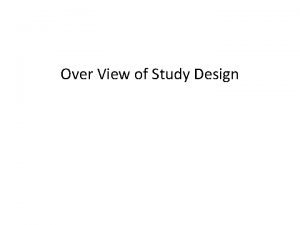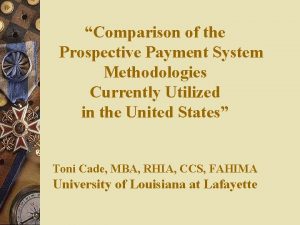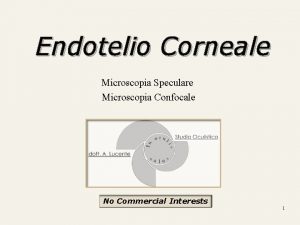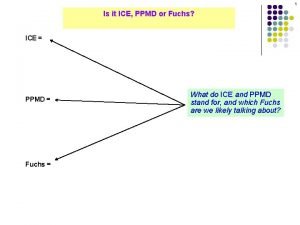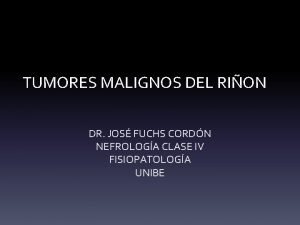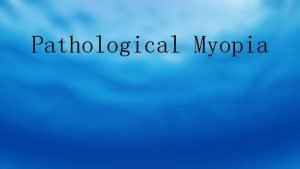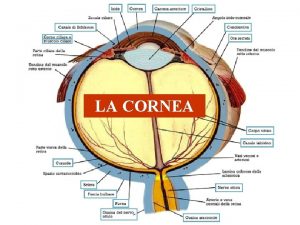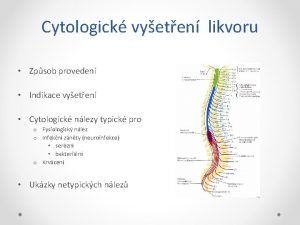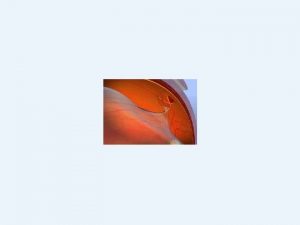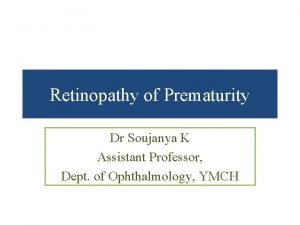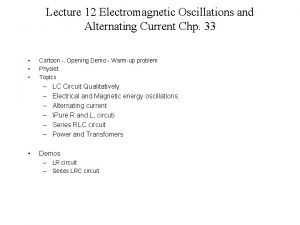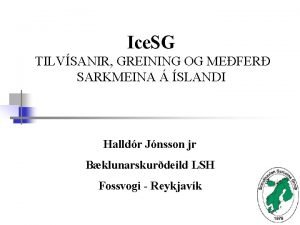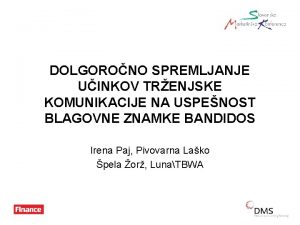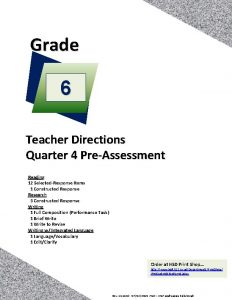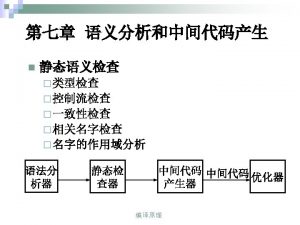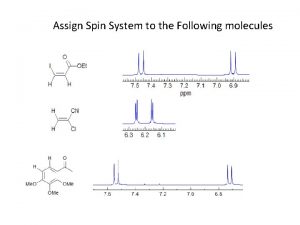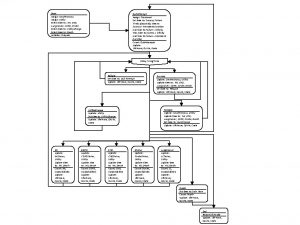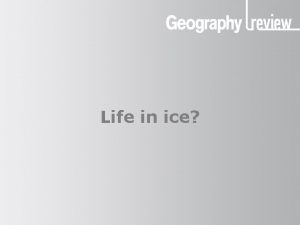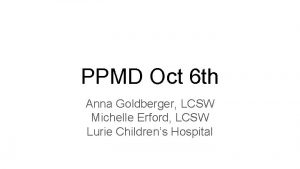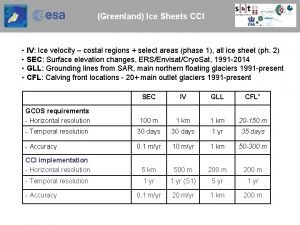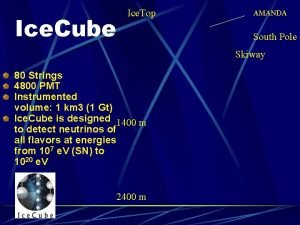1 Is it ICE PPMD or Fuchs Assign


























































- Slides: 58

1 Is it ICE, PPMD or Fuchs? Assign each statement to the proper condition ICE = PPMD = Fuchs = What do ICE and PPMD stand for, and which Fuchs are we likely talking about?

2 Is it ICE, PPMD or Fuchs? Assign each statement to the proper condition ICE = Iridocorneal endothelial syndrome PPMD = Posterior polymorphous dystrophy Fuchs = Fuchs endothelial dystrophy

3 Is it ICE, PPMD or Fuchs? Assign each statement to the proper condition ICE -- Laterality: Which is… --Essentially always unilateral --Essentially always bilateral --Bilateral, but can be so asymmetric as to appear unilateral PPMD -- Fuchs --

4 Is it ICE, PPMD or Fuchs? Assign each statement to the proper condition ICE --Essentially always unilateral Laterality: Which is… --Essentially always unilateral --Essentially always bilateral --Bilateral, but can be so asymmetric as to appear unilateral PPMD --Bilateral, but can be so asymmetric as to appear unilateral Fuchs --Essentially always bilateral

5 Is it ICE, PPMD or Fuchs? Assign each statement to the proper condition ICE --Essentially always unilateral -- Etiology: Which is… --Autosomal dominant (2 of them) --Nonfamilial PPMD --Bilateral, but can be so asymmetric as to appear unilateral -- Fuchs --Essentially always bilateral --

6 Is it ICE, PPMD or Fuchs? Assign each statement to the proper condition ICE --Essentially always unilateral --Nonfamilial Etiology: Which is… --Autosomal dominant (2 of them) --Nonfamilial PPMD --Bilateral, but can be so asymmetric as to appear unilateral --Autosomal dominant Fuchs --Essentially always bilateral --Autosomal dominant

7 Is it ICE, PPMD or Fuchs? Assign each statement to the proper condition ICE --Essentially always unilateral --Nonfamilial -- Gender predilection: Which is… --Female > male --Female = male PPMD --Bilateral, but can be so asymmetric as to appear unilateral --Autosomal dominant -- Fuchs --Essentially always bilateral --Autosomal dominant --

8 Is it ICE, PPMD or Fuchs? Assign each statement to the proper condition ICE --Essentially always unilateral --Nonfamilial --Female > male Gender predilection: Which is… --Female > male --Female = male PPMD --Bilateral, but can be so asymmetric as to appear unilateral --Autosomal dominant --Female = male Fuchs --Essentially always bilateral --Autosomal dominant --Female > male

9 Is it ICE, PPMD or Fuchs? Assign each statement to the proper condition ICE --Essentially always unilateral --Nonfamilial --Female > male -- Classic endothelial finding: Which has… --Guttae --Bands, vesicles, variable opacities --’Hammered silver’ appearance PPMD --Bilateral, but can be so asymmetric as to appear unilateral --Autosomal dominant --Female = male -- Fuchs --Essentially always bilateral --Autosomal dominant --Female > male --

10 Is it ICE, PPMD or Fuchs? Assign each statement to the proper condition ICE --Essentially always unilateral --Nonfamilial --Female > male --’Hammered silver’ appearance Classic endothelial finding: Which has… --Guttae --Bands, vesicles, variable opacities --’Hammered silver’ appearance PPMD --Bilateral, but can be so asymmetric as to appear unilateral --Autosomal dominant --Female = male --Bands, vesicles, variable opacities Fuchs --Essentially always bilateral --Autosomal dominant --Female > male --Guttae

11 Is it ICE, PPMD or Fuchs? Assign each statement to the proper condition Low res High res ICE: ‘Hammered silver’ corneal endothelium

12 Is it ICE, PPMD or Fuchs? Assign each statement to the proper condition Direct illumination Retroillumination Fuchs: Cornea guttata

13 Is it ICE, PPMD or Fuchs? Assign each statement to the proper condition Snail or railroad tracks Vesicular lesions Endothelial plaque-like lesions PPMD The clinical appearance of PPMD is highly variable

14 Is it ICE, PPMD or Fuchs? Assign each statement to the proper condition ICE --Essentially always unilateral --Nonfamilial --Female > male --’Hammered silver’ appearance -- Glaucoma status: Which has a… --Strong association with glaucoma --? No association with glaucoma? --Modest association with glaucoma PPMD --Bilateral, but can be so asymmetric as to appear unilateral --Autosomal dominant --Female = male --Bands, vesicles, variable opacities -- Fuchs --Essentially always bilateral --Autosomal dominant --Female > male --Guttae --

15 Is it ICE, PPMD or Fuchs? Assign each statement to the proper condition ICE --Essentially always unilateral --Nonfamilial --Female > male --’Hammered silver’ appearance --Strong association with glaucoma Glaucoma status: Which has a… --Strong association with glaucoma --? No association with glaucoma? --Modest association with glaucoma PPMD --Bilateral, but can be so asymmetric as to appear unilateral --Autosomal dominant --Female = male --Bands, vesicles, variable opacities --Modest association with glaucoma Fuchs --Essentially always bilateral --Autosomal dominant --Female > male --Guttae --? No association with glaucoma?

16 Is it ICE, PPMD or Fuchs? Assign each statement to the proper condition ICE --Essentially always unilateral --Nonfamilial --Female > male --’Hammered silver’ appearance --Strong association with glaucoma -- Cornea status: For which is it the case that… --Corneal edema common --Corneal edema can occur, but is not a hallmark --Corneal edema a defining feature of some forms PPMD --Bilateral, but can be so asymmetric as to appear unilateral --Autosomal dominant --Female = male --Bands, vesicles, variable opacities --Modest association with glaucoma -Fuchs --Essentially always bilateral --Autosomal dominant --Female > male --Guttae --? No association with glaucoma? --

17 Is it ICE, PPMD or Fuchs? Assign each statement to the proper condition ICE Cornea status: For which is it the case that… --Essentially always unilateral --Corneal edema common --Nonfamilial --Corneal edema can occur, but is not a hallmark --Female > male --Corneal edema a defining feature of some forms --’Hammered silver’ appearance --Strong association with glaucoma --Corneal edema a defining feature of some forms PPMD --Bilateral, but can be so asymmetric as to appear unilateral --Autosomal dominant --Female = male --Bands, vesicles, variable opacities --Modest association with glaucoma --Corneal edema can occur, but is not a hallmark Fuchs --Essentially always bilateral --Autosomal dominant --Female > male --Guttae --? No association with glaucoma? --Corneal edema common

18 Is it ICE, PPMD or Fuchs? Assign each statement to the proper condition ICE --Essentially always unilateral --Nonfamilial --Female > male --’Hammered silver’ appearance --Strong association with glaucoma --Corneal edema a defining feature of some forms PPMD --Bilateral, but can be so asymmetric as to appear unilateral --Autosomal dominant --Female = male --Bands, vesicles, variable opacities --Modest association with glaucoma --Corneal edema can occur, but is not a hallmark Fuchs --Essentially always bilateral --Autosomal dominant --Female > male --Guttae --? No association with glaucoma? --Corneal edema common (Summary/review slide—no question, proceed when ready)

19 Is it ICE, PPMD or Fuchs? Assign each statement to the proper condition ICE --Essentially always unilateral --Nonfamilial --Female > male --’Hammered silver’ appearance --Strong association with glaucoma --Corneal edema a defining feature of some forms What are the different subtypes of ICE? PPMD Two well established accepted; they are: --Bilateral, but can beare so asymmetric as toand appear unilateral --Chandler syndrome --Autosomal dominant --Female = male--Essential (progressive) iris atrophy --Bands, vesicles, variable The statusopacities of the other two are subject to debate; they are: --Modest association with glaucoma --Cogan-Reese syndrome --Corneal edema--Iris can nevus occur, syndrome but is not a hallmark (See the ICE slide set for more details. ) Fuchs --Essentially always bilateral --Autosomal dominant --Female > male --Guttae --? No association with glaucoma? --Corneal edema common

20 Is it ICE, PPMD or Fuchs? Assign each statement to the proper condition ICE --Essentially always unilateral --Nonfamilial --Female > male --’Hammered silver’ appearance --Strong association with glaucoma --Corneal edema a defining feature of some forms What are the different subtypes of ICE? PPMD Two well established accepted; they are: --Bilateral, but can beare so asymmetric as toand appear unilateral --Chandler syndrome --Autosomal dominant --Female = male--Essential (progressive) iris atrophy --Bands, vesicles, variable The statusopacities of the other two are subject to debate; they are: --Modest association with glaucoma --Cogan-Reese syndrome --Corneal edema--Iris can nevus occur, syndrome but is not a hallmark (See the ICE slide set for more details. ) Fuchs --Essentially always bilateral --Autosomal dominant --Female > male --Guttae --? No association with glaucoma? --Corneal edema common

21 Is it ICE, PPMD or Fuchs? Assign each statement to the proper condition ICE --Essentially always unilateral --Nonfamilial --Female > male --’Hammered silver’ appearance --Strong association with glaucoma --Corneal edema a defining feature of some forms What are the different subtypes of ICE? PPMD Two well established accepted; they are: --Bilateral, but can beare so asymmetric as toand appear unilateral --Chandler syndrome --Autosomal dominant --Female = male--Essential (progressive) iris atrophy --Bands, vesicles, variable The statusopacities of the other two are subject to debate; they are: --Modest association with glaucoma --Cogan-Reese syndrome --Corneal edema--Iris can occur, is not a hallmark nevus but syndrome (See the ICE slide set for more details. ) Fuchs --Essentially always bilateral --Autosomal dominant --Female > male --Guttae --? No association with glaucoma? --Corneal edema common

22 Is it ICE, PPMD or Fuchs? Assign each statement to the proper condition ICE --Essentially always unilateral --Nonfamilial --Female > male --’Hammered silver’ appearance --Strong association with glaucoma --Corneal edema a defining feature of some forms What are the different subtypes of ICE? PPMD Two well established accepted; they are: --Bilateral, but can beare so asymmetric as toand appear unilateral --Chandler syndrome --Autosomal dominant --Female = male--Essential (progressive) iris atrophy --Bands, vesicles, variable The statusopacities of the other two are subject to debate; they are: --Modest association with glaucoma --Cogan-Reese syndrome --Corneal edema--Iris can occur, is not a hallmark nevus but syndrome (See the ICE slide set for more details. ) Fuchs --Essentially always bilateral --Autosomal dominant --Female > male --Guttae --? No association with glaucoma? --Corneal edema common

23 Is it ICE, PPMD or Fuchs? Assign each statement to the proper condition ICE --Essentially always unilateral --Nonfamilial --Female > male --’Hammered silver’ appearance --Strong association with glaucoma --Corneal edema a defining feature of some forms What subtypes of ICE? Whatare arethe thedifferent subtypes of ICE? PPMD Two are well andand accepted; they are: Two are wellestablished accepted; they are: --Bilateral, but can be so asymmetric as to appear unilateral --Chandler syndrome --Autosomal dominant --Essential (progressive) iris atrophy --Female = male. The status of the other two are subject to debate; they are: --Bands, vesicles, variable The statusopacities of the other two are subject to debate; they are: --Cogan-Reese syndrome --Modest association with glaucoma --Cogan-Reese syndrome --Iris nevus syndrome --Corneal edema(See canthe occur, but issetnot hallmark --Iris nevus syndrome ICE slide foramore details. ) (See the ICE slide-set, K 26, for more details. ) Fuchs --Essentially always bilateral --Autosomal dominant --Female > male --Guttae --? No association with glaucoma? --Corneal edema common

24 Is it ICE, PPMD or Fuchs? Assign each statement to the proper condition ICE --Essentially always unilateral --Nonfamilial --Female > male --’Hammered silver’ appearance For the OKAP, with I recommend thinking of them as the --Strong association glaucoma Iris nevus (akaof. Cogan-Reese syndrome) --Corneal edema syndrome a defining feature some forms Chandler syndrome What subtypes of ICE? Whatare arethe thedifferent subtypes of ICE? PPMD Essential iris atrophy Two andand accepted; they are: Twoare arewellestablished accepted; they are: BCSC does: --Bilateral, but can be so asymmetric as to appear unilateral --Chandler syndrome --Autosomal dominant --Essential (progressive) iris atrophy --Female = male. The --Essential (progressive) iristoatrophy status of the other two are subject debate; they are: --Bands, vesicles, variable opacities The status of the other two are subject to debate; they are: --Cogan-Reese syndrome --Modest association with glaucoma --Iris nevus syndrome --Cogan-Reese syndrome --Corneal edema(See canthe occur, but is hallmark ICE slide setnot foramore details. ) --Iris nevus syndrome (See the ICE slide set, K 26, for more details. ) Fuchs --Essentially always bilateral --Autosomal dominant --Female > male --Guttae --? No association with glaucoma? --Corneal edema common

25 Is it ICE, PPMD or Fuchs? Assign each statement to the proper condition ICE --Essentially always unilateral --Nonfamilial --Female > male --’Hammered silver’ appearance For the OKAP, with I recommend thinking of them as the --Strong association glaucoma --Corneal edema syndrome a defining feature some forms Iris nevus (akaof. Cogan-Reese syndrome) BCSC does: Chandler syndrome Note that of doing this facilitates a very useful What are the different subtypes ICE? What are the different subtypes of ICE? PPMD mnemonic for remembering the ICE subtypes! Essential iris atrophy Two andand accepted; they are: Twoare arewellestablished accepted; they are: --Bilateral, but can be so asymmetric as to appear unilateral --Chandler syndrome --Autosomal dominant --Essential (progressive) iris atrophy --Female = male. The --Essential (progressive) iristoatrophy status of the other two are subject debate; they are: --Bands, vesicles, variable opacities The status of the other two are subject to debate; they are: --Cogan-Reese syndrome --Modest association with glaucoma --Iris nevus syndrome --Cogan-Reese syndrome --Corneal edema(See canthe occur, but is hallmark ICE slide setnot foramore details. ) --Iris nevus syndrome (See the ICE slide set, K 26, for more details. ) Fuchs --Essentially always bilateral --Autosomal dominant --Female > male --Guttae --? No association with glaucoma? --Corneal edema common

26 Is it ICE, PPMD or Fuchs? Assign each statement to the proper condition ICE --Essentially always unilateral --Nonfamilial --Female > male --’Hammered silver’ appearance --Strong association with glaucoma --Corneal edema a defining feature of some forms For which form. What is theare presence of significant corneal edema a defining the different subtypes of ICE? What are the different subtypes of ICE? PPMD feature? Two are well andand accepted; they are: Two are wellestablished accepted; they are: --Bilateral, but can be so asymmetric as to appear unilateral Chandler syndrome --Chandler syndrome? --Autosomal dominant --Essential (progressive) iris atrophy --Female = male. The --Essential (progressive) iristoatrophy? status of the other two are subject debate; they are: --Bands, vesicles, variable opacities The status of the other two are subject to debate; they are: --Cogan-Reese syndrome --Modest association with glaucoma --Iris nevus syndrome --Cogan-Reese syndrome --Corneal edema(See canthe occur, but is hallmark ICE slide setnot foramore details. ) --Iris nevus syndrome? (See the ICE slide set, K 26, for more details. ) Fuchs --Essentially always bilateral --Autosomal dominant --Female > male --Guttae --? No association with glaucoma? --Corneal edema common

27 Is it ICE, PPMD or Fuchs? Assign each statement to the proper condition ICE --Essentially always unilateral --Nonfamilial --Female > male --’Hammered silver’ appearance --Strong association with glaucoma --Corneal edema a defining feature of some forms For which form. What is theare presence of significant corneal edema a defining the different subtypes of ICE? What are the different subtypes of ICE? PPMD feature? Two are well andand accepted; they are: Two are wellestablished accepted; they are: --Bilateral, but can be so asymmetric as to appear unilateral Chandler syndrome --Chandler syndrome! --Autosomal dominant --Essential (progressive) iris atrophy --Female = male. The --Essential (progressive) iristoatrophy status of the other two are subject debate; they are: --Bands, vesicles, variable opacities The status of the other two are subject to debate; they are: --Cogan-Reese syndrome --Modest association with glaucoma --Iris nevus syndrome --Cogan-Reese syndrome --Corneal edema(See canthe occur, but is hallmark ICE slide setnot foramore details. ) --Iris nevus syndrome (See the ICE slide set, K 26, for more details. ) Fuchs --Essentially always bilateral --Autosomal dominant --Female > male --Guttae --? No association with glaucoma? --Corneal edema common

28 Is it ICE, PPMD or Fuchs? Assign each statement to the proper condition ICE --Essentially always unilateral --Nonfamilial --Female > male --’Hammered silver’ appearance --Strong association with glaucoma --Corneal edema a defining feature of some forms PPMD --Bilateral, but can be so asymmetric as to appear unilateral What is abnormal about the endothelial cells in PPMD? --Autosomal dominant In PPMD, the endothelial cells ‘behave’ like epithelial cells and/or fibroblasts; --Female = male form multiple layers, and migrate ie, they proliferate, --Bands, vesicles, variable opacities --Modest association with glaucoma --Corneal edema can occur, but is not a hallmark Fuchs --Essentially always bilateral --Autosomal dominant --Female > male --Guttae --? No association with glaucoma? --Corneal edema common

29 Is it ICE, PPMD or Fuchs? Assign each statement to the proper condition ICE --Essentially always unilateral --Nonfamilial --Female > male --’Hammered silver’ appearance --Strong association with glaucoma --Corneal edema a defining feature of some forms PPMD --Bilateral, but can be so asymmetric as to appear unilateral What is abnormal about the endothelial cells in PPMD? --Autosomal dominant In PPMD, the endothelial cells ‘behave’ like epithelial cells and/or fibroblasts; --Female = male form multiple layers, and migrate ie, they proliferate, --Bands, vesicles, variable opacities --Modest association with glaucoma --Corneal edema can occur, but is not a hallmark Fuchs --Essentially always bilateral --Autosomal dominant --Female > male --Guttae --? No association with glaucoma? --Corneal edema common

30 Is it ICE, PPMD or Fuchs? Assign each statement to the proper condition Normal cornea. Note the single-cell-thick nature of the endothelial cells.

31 Is it ICE, PPMD or Fuchs? Assign each statement to the proper condition Normal cornea. Note the single-cell-thick nature of the endothelial cells. PPMD. Instead of being lined by cells with the attributes of corneal endothelium, the posterior cornea is covered by cells with epithelial- or fibroblast-like features.

32 Is it ICE, PPMD or Fuchs? Assign each statement to the proper condition ICE --Essentially always unilateral --Nonfamilial --Female > male --’Hammered silver’ appearance --Strong association with glaucoma --Corneal edema a defining feature of some forms PPMD --Bilateral, but can be so asymmetric as to appear unilateral --Autosomal dominant --Female = male --Bands, vesicles, variable opacities --Modest association with glaucoma --Corneal edema can occur, but is not a hallmark What condition manifests findings that render it easily confusable with PPMD? Fuchs Iridocorneal endothelial (ICE) syndrome --Essentially always bilateral How can you tell if a pt has PPMD vs ICE? --Autosomal dominant --Unlike PPMD, ICE is always sporadic --Female > male --Unlike --Guttae. PPMD, ICE is always unilateral --? No association with glaucoma? --Corneal edema common

33 Is it ICE, PPMD or Fuchs? Assign each statement to the proper condition ICE --Essentially always unilateral --Nonfamilial --Female > male --’Hammered silver’ appearance --Strong association with glaucoma --Corneal edema a defining feature of some forms PPMD --Bilateral, but can be so asymmetric as to appear unilateral --Autosomal dominant --Female = male --Bands, vesicles, variable opacities --Modest association with glaucoma --Corneal edema can occur, but is not a hallmark What condition manifests findings that render it easily confusable with PPMD? Fuchs Iridocorneal endothelial (ICE) syndrome --Essentially always bilateral How can you tell if a pt has PPMD vs ICE? --Autosomal dominant --Unlike PPMD, ICE is always sporadic --Female > male --Unlike --Guttae. PPMD, ICE is always unilateral --? No association with glaucoma? --Corneal edema common

34 Is it ICE, PPMD or Fuchs? Assign each statement to the proper condition ICE --Essentially always unilateral --Nonfamilial --Female > male --’Hammered silver’ appearance --Strong association with glaucoma --Corneal edema a defining feature of some forms PPMD --Bilateral, but can be so asymmetric as to appear unilateral --Autosomal dominant --Female = male --Bands, vesicles, variable opacities --Modest association with glaucoma --Corneal edema can occur, but is not a hallmark What condition manifests findings that render it easily confusable with PPMD? Fuchs Iridocorneal endothelial (ICE) syndrome --Essentially always bilateral How can you tell if a pt has PPMD vs ICE? --Autosomal dominant --Unlike PPMD, ICE is always sporadic --Female > male --Unlike --Guttae. PPMD, ICE is always unilateral --? No association with glaucoma? --Corneal edema common

35 Is it ICE, PPMD or Fuchs? Assign each statement to the proper condition ICE --Essentially always unilateral --Nonfamilial --Female > male --’Hammered silver’ appearance --Strong association with glaucoma --Corneal edema a defining feature of some forms PPMD --Bilateral, but can be so asymmetric as to appear unilateral --Autosomal dominant --Female = male --Bands, vesicles, variable opacities --Modest association with glaucoma --Corneal edema can occur, but is not a hallmark What condition manifests findings that render it easily confusable with PPMD? Fuchs Iridocorneal endothelial (ICE) syndrome --Essentially always bilateral How can you tell if a pt has PPMD vs ICE? --Autosomal dominant --Unlike PPMD, ICE is always… --Female > male --Unlike --Guttae. PPMD, ICE is always… --? No association with glaucoma? --Corneal edema common

36 Is it ICE, PPMD or Fuchs? Assign each statement to the proper condition ICE --Essentially always unilateral --Nonfamilial --Female > male --’Hammered silver’ appearance --Strong association with glaucoma --Corneal edema a defining feature of some forms PPMD --Bilateral, but can be so asymmetric as to appear unilateral --Autosomal dominant --Female = male --Bands, vesicles, variable opacities --Modest association with glaucoma --Corneal edema can occur, but is not a hallmark What condition manifests findings that render it easily confusable with PPMD? Fuchs Iridocorneal endothelial (ICE) syndrome --Essentially always bilateral How can you tell if a pt has PPMD vs ICE? --Autosomal dominant --Unlike PPMD, ICE is always…unilateral --Female > male --Unlike --Guttae. PPMD, ICE is always… --? No association with glaucoma? --Corneal edema common

37 Is it ICE, PPMD or Fuchs? Assign each statement to the proper condition ICE --Essentially always unilateral --Nonfamilial --Female > male --’Hammered silver’ appearance --Strong association with glaucoma --Corneal edema a defining feature of some forms PPMD --Bilateral, but can be so asymmetric as to appear unilateral --Autosomal dominant --Female = male --Bands, vesicles, variable opacities --Modest association with glaucoma --Corneal edema can occur, but is not a hallmark What condition manifests findings that render it easily confusable with PPMD? Fuchs Iridocorneal endothelial (ICE) syndrome --Essentially always bilateral How can you tell if a pt has PPMD vs ICE? --Autosomal dominant --Unlike PPMD, ICE is always…unilateral --Female > male --Unlike --Guttae. PPMD, ICE is always…sporadic --? No association with glaucoma? --Corneal edema common

38 Is it ICE, PPMD or Fuchs? Assign each statement to the proper condition ICE --Essentially always unilateral --Nonfamilial --Female > male --’Hammered silver’ appearance --Strong association with glaucoma --Corneal edema a defining feature of some forms What are guttae? Wartlike excrescences on Descemet’s membrane PPMD --Bilateral, but can be so asymmetric as to appear unilateral What is the colorful description of the appearance of the endothelium in Fuchs? --Autosomal dominant ‘Beaten bronze’ --Female = male --Bands, vesicles, variable opacities What is the histologic hallmark of Fuchs on confocal microscopy? --Modest association with glaucoma Endothelial cell abnormalities --Corneal edema can occur, but is not a including: hallmark --The presence of guttata (duh) --Decreased cell density --The presence of cells that are much too large ( polymegathism ) --An increase in cell-to-cell variability in size ( pleomorphism ) Fuchs --Essentially always bilateral --Autosomal dominant --Female > male --Guttae --? No association with glaucoma? --Corneal edema common

39 Is it ICE, PPMD or Fuchs? Assign each statement to the proper condition ICE --Essentially always unilateral --Nonfamilial --Female > male --’Hammered silver’ appearance --Strong association with glaucoma --Corneal edema a defining feature of some forms What are guttae? Wartlike excrescences on Descemet’s membrane PPMD --Bilateral, but can be so asymmetric as to appear unilateral What is the colorful description of the appearance of the endothelium in Fuchs? --Autosomal dominant ‘Beaten bronze’ --Female = male --Bands, vesicles, variable opacities What is the histologic hallmark of Fuchs on confocal microscopy? --Modest association with glaucoma Endothelial cell abnormalities --Corneal edema can occur, but is not a including: hallmark --The presence of guttata (duh) --Decreased cell density --The presence of cells that are much too large ( polymegathism ) --An increase in cell-to-cell variability in size ( pleomorphism ) Fuchs --Essentially always bilateral --Autosomal dominant --Female > male --Guttae --? No association with glaucoma? --Corneal edema common

40 Is it ICE, PPMD or Fuchs? Assign each statement to the proper condition Fuchs endothelial corneal dystrophy. Light microscopy: cornea guttata in the form of focal excrescences at the level of the endothelium.

41 Is it ICE, PPMD or Fuchs? Assign each statement to the proper condition ICE --Essentially always unilateral --Nonfamilial --Female > male --’Hammered silver’ appearance --Strong association with glaucoma --Corneal edema a defining feature of some forms What are guttae? Wartlike excrescences on Descemet’s membrane PPMD --Bilateral, but can be so asymmetric as to appear unilateral What is the colorful description of the appearance of the endothelium in Fuchs? --Autosomal dominant ‘Beaten bronze’ --Female = male --Bands, vesicles, variable opacities What is the histologic hallmark of Fuchs on confocal microscopy? --Modest association with glaucoma Endothelial cell abnormalities --Corneal edema can occur, but is not a including: hallmark --The presence of guttata (duh) --Decreased cell density --The presence of cells that are much too large ( polymegathism ) --An increase in cell-to-cell variability in size ( pleomorphism ) Fuchs --Essentially always bilateral --Autosomal dominant --Female > male --Guttae --? No association with glaucoma? --Corneal edema common

42 Is it ICE, PPMD or Fuchs? Assign each statement to the proper condition ICE --Essentially always unilateral --Nonfamilial --Female > male --’Hammered silver’ appearance --Strong association with glaucoma --Corneal edema a defining feature of some forms What are guttae? Wartlike excrescences on Descemet’s membrane PPMD --Bilateral, but can be so asymmetric as to appear unilateral What is the colorful description of the appearance of the endothelium in Fuchs? --Autosomal dominant ‘Beaten bronze’ --Female = male --Bands, vesicles, variable opacities What is the histologic hallmark of Fuchs on confocal microscopy? --Modest association with glaucoma Endothelial cell abnormalities --Corneal edema can occur, but is not a including: hallmark --The presence of guttata (duh) --Decreased cell density --The presence of cells that are much too large ( polymegathism ) --An increase in cell-to-cell variability in size ( pleomorphism ) Fuchs --Essentially always bilateral --Autosomal dominant --Female > male --Guttae --? No association with glaucoma? --Corneal edema common

43 Is it ICE, PPMD or Fuchs? Assign each statement to the proper condition Fuchs endothelial corneal dystrophy. The appearance wrought by dense guttata has been likened to that of ‘beaten bronze. ’

44 Is it ICE, PPMD or Fuchs? Assign each statement to the proper condition ICE --Essentially always unilateral --Nonfamilial --Female > male --’Hammered silver’ appearance --Strong association with glaucoma --Corneal edema a defining feature of some forms What are guttae? Wartlike excrescences on Descemet’s membrane PPMD --Bilateral, but can be so asymmetric as to appear unilateral What is the colorful description of the appearance of the endothelium in Fuchs? --Autosomal dominant ‘Beaten bronze’ --Female = male --Bands, vesicles, variable opacities Don’t confuse beaten bronze with hammered What is the histologic hallmark of Fuchs on confocal microscopy? silver! --Modest association with glaucoma Endothelial cell abnormalities --Corneal edema can occur, but is not a including: hallmark --The presence of guttata (duh) --Decreased cell density --The presence of cells that are much too large ( polymegathism ) --An increase in cell-to-cell variability in size ( pleomorphism ) Fuchs --Essentially always bilateral --Autosomal dominant --Female > male --Guttae --? No association with glaucoma? --Corneal edema common --Appearance? ‘Beaten bronze’

45 Is it ICE, PPMD or Fuchs? Assign each statement to the proper condition ICE --Essentially always unilateral --Nonfamilial --Female > male --’Hammered silver’ appearance --Strong association with glaucoma --Corneal edema a defining feature of some forms What are guttae? Wartlike excrescences on Descemet’s membrane PPMD --Bilateral, but can be so asymmetric as to appear unilateral What is the colorful description of the appearance of the endothelium in Fuchs? --Autosomal dominant ‘Beaten bronze’ --Female = male --Bands, vesicles, variable opacities What is the histologic hallmark of Fuchs on confocal microscopy? --Modest association with glaucoma Endothelial cell abnormalities --Corneal edema can occur, but is not a including: hallmark --The presence of guttata (duh) --Decreased cell density --The presence of cells that are much too large ( polymegathism ) --An increase in cell-to-cell variability in size ( pleomorphism ) Fuchs --Essentially always bilateral --Autosomal dominant --Female > male --Guttae --? No association with glaucoma? --Corneal edema common

46 Is it ICE, PPMD or Fuchs? Assign each statement to the proper condition ICE --Essentially always unilateral --Nonfamilial --Female > male --’Hammered silver’ appearance --Strong association with glaucoma --Corneal edema a defining feature of some forms What are guttae? Wartlike excrescences on Descemet’s membrane PPMD --Bilateral, but can be so asymmetric as to appear unilateral What is the colorful description of the appearance of the endothelium in Fuchs? --Autosomal dominant ‘Beaten bronze’ --Female = male --Bands, vesicles, variable opacities What is the histologic hallmark of Fuchs on confocal microscopy? --Modest association with glaucoma Endothelial cell abnormalities --Corneal edema can occur, but is not a including: hallmark --The presence of guttata (duh) --Decreased cell density --The presence of cells that are much too large ( polymegathism ) --An increase in cell-to-cell variability in size ( pleomorphism ) Fuchs --Essentially always bilateral --Autosomal dominant --Female > male --Guttae --? No association with glaucoma? --Corneal edema common

47 Is it ICE, PPMD or Fuchs? Assign each statement to the proper condition ICE --Essentially always unilateral --Nonfamilial --Female > male --’Hammered silver’ appearance --Strong association with glaucoma --Corneal edema a defining feature of some forms What are guttae? Wartlike excrescences on Descemet’s membrane PPMD --Bilateral, but can be so asymmetric as to appear unilateral What is the colorful description of the appearance of the endothelium in Fuchs? --Autosomal dominant ‘Beaten bronze’ --Female = male --Bands, vesicles, variable opacities What is the histologic hallmark of Fuchs on confocal microscopy? --Modest association with glaucoma Endothelial cell abnormalities --Corneal edema can occur, but is not a including: hallmark --The presence of guttata (duh) --Decreased cell density --The presence of cells that are much too large ( polymegathism ) --An increase in cell-to-cell variability in size ( pleomorphism ) Fuchs --Essentially always bilateral --Autosomal dominant --Female > male --Guttae --? No association with glaucoma? --Corneal edema common

48 Is it ICE, PPMD or Fuchs? Assign each statement to the proper condition ICE --Essentially always unilateral --Nonfamilial --Female > male --’Hammered silver’ appearance --Strong association with glaucoma --Corneal edema a defining feature of some forms What are guttae? Wartlike excrescences on Descemet’s membrane PPMD --Bilateral, but can be so asymmetric as to appear unilateral What is the colorful description of the appearance of the endothelium in Fuchs? --Autosomal dominant ‘Beaten bronze’ --Female = male --Bands, vesicles, variable opacities What is the histologic hallmark of Fuchs on confocal microscopy? --Modest association with glaucoma Endothelial cell abnormalities --Corneal edema can occur, but is not a including: hallmark --The presence of guttata (duh) --Decreased cell density --The presence of cells that are much too large ( polymegathism ) --An increase in cell-to-cell variability in size ( pleomorphism ) Fuchs --Essentially always bilateral --Autosomal dominant --Female > male --Guttae --? No association with glaucoma? --Corneal edema common

49 Is it ICE, PPMD or Fuchs? Assign each statement to the proper condition Normal human cornea. Note numerous endothelial cell nuclei lining the posterior surface (arrow).

50 Is it ICE, PPMD or Fuchs? Assign each statement to the proper condition Normal human cornea. Note numerous endothelial cell nuclei lining the posterior surface (arrow). Fuchs endothelial corneal dystrophy. Light microscopy section of FED cornea. Note the markedly thickened Descemet’s membrane and the absence of endothelial cell nuclei on the posterior surface (dashed arrow).

51 Is it ICE, PPMD or Fuchs? Assign each statement to the proper condition Specular microscopic image, normal cornea. Note the plethora of polygonal cells of uniform size, and the absence of empty spaces. The cell density is 2949/mm 2 (nl 2 -3 K, avg ~2400)

52 Is it ICE, PPMD or Fuchs? Assign each statement to the proper condition Specular microscopic image, normal cornea. Note the plethora of polygonal cells of uniform size, and the absence of empty spaces. The cell density is 2949/mm 2 (nl 2 -3 K, avg ~2400) Specular microscopic image, Fuchs. Note the polymegathism and polymorphism, and the empty spaces (= guttata). Note that the cell density is only 1763/mm 2.

53 Is it ICE, PPMD or Fuchs? Assign each statement to the proper condition ICE --Essentially always unilateral --Nonfamilial --Female > male --’Hammered silver’ appearance --Strong association with glaucoma How strong is this association? Very— 80 --Corneal edema a defining feature of some forms to 100% of ICE pts have glaucoma PPMD --Bilateral, but can be so asymmetric as to appear unilateral --Autosomal dominant --Female = male --Bands, vesicles, variable opacities --Modest association with glaucoma --Corneal edema can occur, but is not a hallmark Fuchs --Essentially always bilateral --Autosomal dominant --Female > male --Guttae --? No association with glaucoma? --Corneal edema common

54 Is it ICE, PPMD or Fuchs? Assign each statement to the proper condition ICE --Essentially always unilateral --Nonfamilial --Female > male --’Hammered silver’ appearance --Strong association with glaucoma How strong is this association? Very— 80 --Corneal edema a defining feature of some forms to 100% of ICE pts have glaucoma PPMD --Bilateral, but can be so asymmetric as to appear unilateral --Autosomal dominant --Female = male --Bands, vesicles, variable opacities --Modest association with glaucoma --Corneal edema can occur, but is not a hallmark Fuchs --Essentially always bilateral --Autosomal dominant --Female > male --Guttae --? No association with glaucoma? --Corneal edema common

55 Is it ICE, PPMD or Fuchs? Assign each statement to the proper condition ICE --Essentially always unilateral --Nonfamilial --Female > male --’Hammered silver’ appearance --Strong association with glaucoma --Corneal edema a defining feature of some forms PPMD --Bilateral, but can be so asymmetric as to appear unilateral --Autosomal dominant --Female = male --Bands, vesicles, variable opacities How modest is this one? --Modest association with glaucoma ~25% of PPMD pts have glaucoma --Corneal edema can occur, but is not a hallmark Fuchs --Essentially always bilateral --Autosomal dominant --Female > male --Guttae --? No association with glaucoma? --Corneal edema common

56 Is it ICE, PPMD or Fuchs? Assign each statement to the proper condition ICE --Essentially always unilateral --Nonfamilial --Female > male --’Hammered silver’ appearance --Strong association with glaucoma --Corneal edema a defining feature of some forms PPMD --Bilateral, but can be so asymmetric as to appear unilateral --Autosomal dominant --Female = male --Bands, vesicles, variable opacities How modest is this one? --Modest association with glaucoma ~25% of PPMD pts have glaucoma --Corneal edema can occur, but is not a hallmark Fuchs --Essentially always bilateral --Autosomal dominant --Female > male --Guttae --? No association with glaucoma? --Corneal edema common

57 Is it ICE, PPMD or Fuchs? Assign each statement to the proper condition ICE --Essentially always unilateral --Nonfamilial --Female > male --’Hammered silver’ appearance --Strong association with glaucoma --Corneal edema a defining feature of some forms PPMD --Bilateral, but can be so asymmetric as to appear unilateral --Autosomal dominant --Female = male --Bands, vesicles, variable opacities --Modest association with glaucoma --Corneal edema can occur, but is not a hallmark Fuchs --Essentially always bilateral --Autosomal dominant --Female > male --Guttae --? No association with glaucoma? --Corneal edema common Why the equivocation? Experts disagree whether an association exists between Fuch’s and glaucoma

58 Is it ICE, PPMD or Fuchs? Assign each statement to the proper condition ICE --Essentially always unilateral --Nonfamilial --Female > male --’Hammered silver’ appearance --Strong association with glaucoma --Corneal edema a defining feature of some forms PPMD --Bilateral, but can be so asymmetric as to appear unilateral --Autosomal dominant --Female = male --Bands, vesicles, variable opacities --Modest association with glaucoma --Corneal edema can occur, but is not a hallmark Fuchs --Essentially always bilateral --Autosomal dominant --Female > male --Guttae --? No association with glaucoma? --Corneal edema common Why the equivocation? Experts disagree whether an association exists between Fuch’s and glaucoma
 Clear ice vs rime ice
Clear ice vs rime ice Icing
Icing Verilog wire 선언
Verilog wire 선언 Spss random sample
Spss random sample Ascom unite assign
Ascom unite assign Verilog assign 조건문
Verilog assign 조건문 Did investigator assign exposures
Did investigator assign exposures Cutter number examples
Cutter number examples A computer software program that assign appropriate ms-drgs
A computer software program that assign appropriate ms-drgs Ascom unite assign
Ascom unite assign Web assign login
Web assign login Sara fuchs
Sara fuchs Alice fuchs
Alice fuchs Microscopia speculare
Microscopia speculare Hania rosenberg
Hania rosenberg Satteldachkonstruktionen
Satteldachkonstruktionen Gustavo fuchs
Gustavo fuchs Fuchs
Fuchs Fuchs born
Fuchs born Jos fuchs
Jos fuchs Blond fundus
Blond fundus Mooren ulcer
Mooren ulcer Elinor fuchs visit to a small planet
Elinor fuchs visit to a small planet Distrofia di fuchs
Distrofia di fuchs Fuchs rosenthalova komůrka
Fuchs rosenthalova komůrka En qu
En qu Macchia di fuchs
Macchia di fuchs Swissskikwo
Swissskikwo Super traction crescent
Super traction crescent Some say the world will end in fire some say in ice
Some say the world will end in fire some say in ice Canadian ice service
Canadian ice service Led rental display
Led rental display Fdl blueline
Fdl blueline Emma ice cream maker
Emma ice cream maker Ice cube
Ice cube Inline hockey vs ice hockey
Inline hockey vs ice hockey Continental glacier
Continental glacier Warriors fire and ice summary
Warriors fire and ice summary World map if all ice melted interactive
World map if all ice melted interactive Animals that represent freedom
Animals that represent freedom Eli the ice man
Eli the ice man Ice sg
Ice sg Bandidos pivo
Bandidos pivo Ice cream flavors a to z
Ice cream flavors a to z Heaven and hell archetype examples
Heaven and hell archetype examples Burger essay structure
Burger essay structure Ice floats on water just like wood floats on
Ice floats on water just like wood floats on Field trip by aditi sriram answer key
Field trip by aditi sriram answer key Personification of the sun
Personification of the sun A floating ice block is pushed through a displacement
A floating ice block is pushed through a displacement Kp to kc conversion
Kp to kc conversion Sod table in fmea
Sod table in fmea Does cold stone coffee ice cream have caffeine
Does cold stone coffee ice cream have caffeine Vo��n�� miesta ko��ice
Vo��n�� miesta ko��ice Cinquain poem examples
Cinquain poem examples Critical thinking icebreakers
Critical thinking icebreakers Laura marschke
Laura marschke Force picture example
Force picture example Common ion effect and buffers
Common ion effect and buffers






